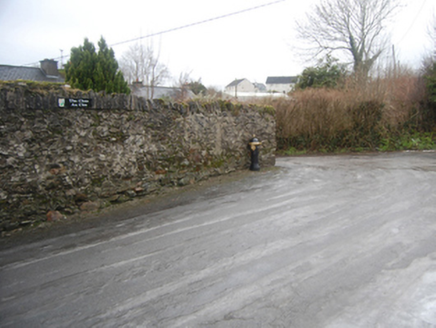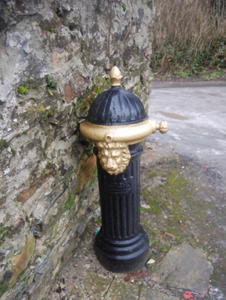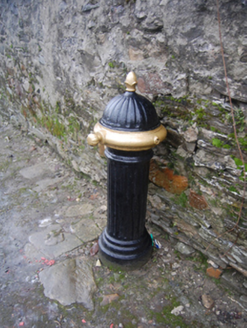Survey Data
Reg No
40833032
Rating
Regional
Categories of Special Interest
Social, Technical
Original Use
Water pump
Date
1880 - 1920
Coordinates
225742, 403114
Date Recorded
11/01/2011
Date Updated
--/--/--
Description
Freestanding cast-iron water hydrant, erected c. 1900, comprising fluted shaft on moulded base surmounted by fluted domed capping with acorn finial over, and having lion's head motif to spout. Pull lever to side. Foundry mark 'Glenfield & Kennedy Ltd, Kilmarnock' to shaft. Sited adjacent to rubble stone wall to the north of the centre of Raphoe adjacent to junction between Irish Row and Close Lane. Located adjacent to the west of former school (see 40833028).
Appraisal
An attractive piece of mass-produced cast-iron, which is an appealing and subtle feature in the streetscape to the north of the centre of Raphoe. This particular example is notable due to its excellent preservation. This water hydrant is of particular importance as a reminder of the mechanisms installed for the supply of clean drinking water in the period before mains water supply systems. The various fluted details, and the moulded lion's head motif in particular, enhances the artistic design quality of the piece, and indicates the equal importance of aesthetics as well as functionality. This lion's head motif may be a reference to the British Empire. The foundry mark indicates that it was made at the Glenfield and Kennedy Ltd. Foundry in Scotland, which was the major company producing and selling cast-iron water mechanisms within the British Empire during the late-nineteenth and early-twentieth century. This example is located adjacent to a road junction to the north of the town centre, a common site for such items of street furniture. It is also located adjacent to a former school (see 40833028), another common site for such artefacts. This example may have replaced an earlier pump at this site depicted on map of the town c. 1905 (Ordnance Survey twenty-five inch map). This simple item of street furniture makes a positive contribution to the streetscape of Raphoe, and is an integral element of the built heritage and social history of the local area.





